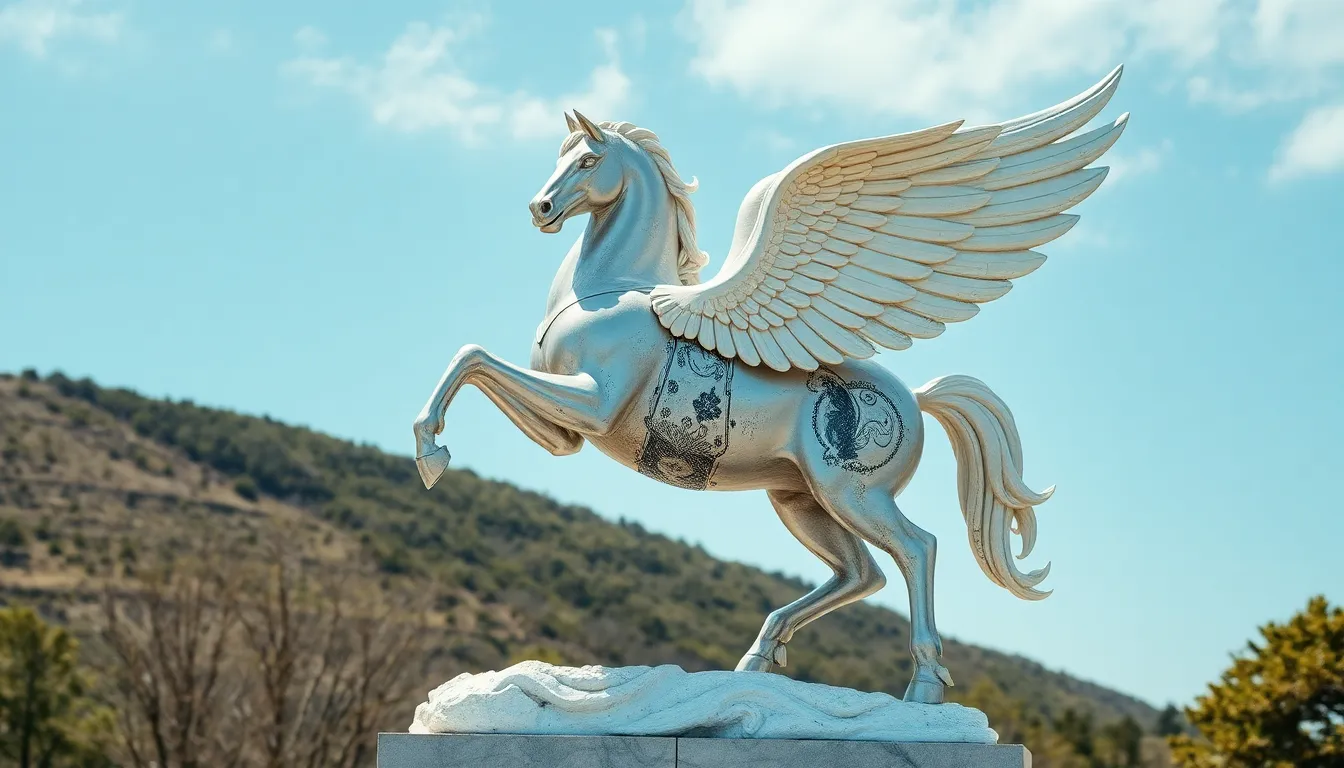Pegasus in Sculpture: Capturing the Essence of the Winged Horse
I. Introduction
Pegasus, the majestic winged horse of Greek mythology, has long captured the imagination of artists and storytellers alike. Born from the blood of the Gorgon Medusa, Pegasus embodies the duality of beauty and chaos, representing both inspiration and tumult. In art and culture, Pegasus transcends mere myth; it symbolizes freedom, creativity, and the pursuit of lofty ideals.
This article aims to explore the representation of Pegasus in sculpture, examining its mythological origins, historical depictions, and the techniques and materials used by artists across different eras. By delving into the iconic sculptures of Pegasus and the thematic interpretations they evoke, we will uncover the enduring legacy of this mythical creature in the world of art.
II. The Mythological Background of Pegasus
Pegasus is a prominent figure within Greek mythology, with roots that trace back to ancient tales. According to legend, he sprang forth from the neck of Medusa when she was slain by the hero Perseus. This extraordinary birth signifies Pegasus’s connection to both beauty and violence.
The symbolism of the winged horse is multifaceted. On one hand, Pegasus represents the freedom of flight and the boundless possibilities of imagination. On the other hand, he also embodies the chaotic nature of the storms and the unpredictability of artistic inspiration.
Pegasus is featured in various myths, most notably as the steed of the hero Bellerophon. Bellerophon rode Pegasus in his quest to defeat the Chimera, a monstrous creature that breathed fire. This tale emphasizes the bravery of the hero and the vital role that Pegasus plays as a companion and ally.
III. Historical Representations of Pegasus in Sculpture
The representation of Pegasus in sculpture spans centuries, showcasing the evolution of artistic styles and cultural significance.
- Ancient Sculptures: In ancient Greece, Pegasus was often depicted in pottery, reliefs, and statues. These works celebrated his divine nature and heroic associations.
- Renaissance Interpretations: The Renaissance revived interest in classical mythology, leading artists such as Michelangelo and Raphael to incorporate Pegasus into their works, emphasizing his beauty and elegance.
- Modern Adaptations: Contemporary artists have reimagined Pegasus in innovative ways, often exploring themes of freedom and transformation through diverse materials and styles.
IV. Techniques and Materials Used in Pegasus Sculptures
The creation of Pegasus sculptures involves a variety of techniques and materials that reflect the artistic practices of their time.
A. Traditional Materials
Historically, artists utilized:
- Marble: Favored for its durability and beauty, marble sculptures of Pegasus often showcase intricate details.
- Bronze: This material allowed for dynamic poses and was often used for larger-than-life representations.
- Stone: Many ancient reliefs featuring Pegasus were carved from stone, capturing the essence of the mythological horse in a more stylized form.
B. Modern Materials
Contemporary artists have embraced new materials, including:
- Fiberglass: Lightweight and versatile, fiberglass allows for larger installations and complex designs.
- Resin: This material enables intricate detailing while being more accessible for mass production.
- Mixed Media: Artists often combine various materials to create unique interpretations and provoke thought.
C. Techniques
Various sculpting techniques are employed, such as:
- Carving: Traditional method of removing material from a solid block.
- Casting: Involves creating a mold and pouring materials like bronze or resin to form the sculpture.
- Assemblage: A modern technique where various objects are combined to create a new artwork.
V. Iconic Sculptures of Pegasus
Throughout history, certain sculptures of Pegasus have emerged as iconic representations of this mythical creature.
- Pegasus Fountain, New York City: Designed by sculptor Paul Manship in 1939, this stunning bronze fountain captures the essence of Pegasus in flight.
- Winged Horse of the Parthenon: Found in the friezes of the Parthenon, these ancient depictions illustrate the significance of Pegasus in Athenian culture.
- Pegasus by Jean-Baptiste Carpeaux: This 19th-century sculpture exemplifies the dynamic movement of the winged horse, showcasing the artist’s mastery of form.
These works exemplify different styles and approaches, reflecting the cultural significance of Pegasus in their respective eras.
VI. Thematic Interpretations of Pegasus in Sculpture
The representation of Pegasus in sculpture often conveys rich thematic interpretations.
A. Exploring Themes of Freedom and Transcendence
Pegasus’s ability to fly symbolizes liberation and the aspiration to rise above earthly limitations.
B. The Representation of Strength and Beauty
Pegasus embodies both physical beauty and strength, making him a powerful symbol in art.
C. The Duality of Pegasus as a Creature of Both Chaos and Inspiration
Pegasus’s origins from Medusa highlight the duality of his nature, representing not only artistic inspiration but also the tumultuous forces of chaos.
VII. The Influence of Pegasus on Contemporary Artists
Modern artists continue to draw inspiration from the myth of Pegasus, incorporating it into contemporary art movements.
A. How Modern Artists are Inspired by the Myth of Pegasus
Artists explore the themes of Pegasus to convey messages about freedom and creativity in today’s society.
B. The Role of Pegasus in Contemporary Art Movements
Pegasus serves as a symbol in various movements, including surrealism and abstract art, where the notion of flight and imagination is celebrated.
C. Case Studies of Current Artists and Their Works Featuring Pegasus
Many contemporary artists, such as Alexander Calder and Damien Hirst, have referenced Pegasus in their works, reinterpreting the myth in innovative ways.
VIII. Conclusion
The significance of Pegasus in sculpture is profound, reflecting the evolution of artistic expression and cultural values over time. From ancient representations to modern adaptations, the winged horse continues to inspire artists and audiences alike.
The enduring legacy of Pegasus in art is a testament to the power of myth to transcend time and space, reminding us of the beauty, chaos, and inspiration that this mythical creature embodies.
As we reflect on the cultural relevance of Pegasus today, we recognize that his story and symbolism will continue to resonate within the realms of art, literature, and beyond, inspiring future generations to dream and create.




